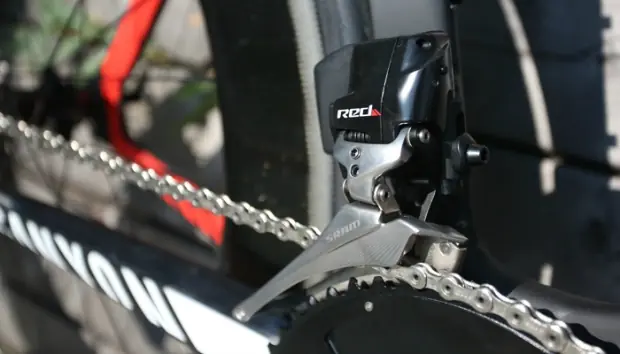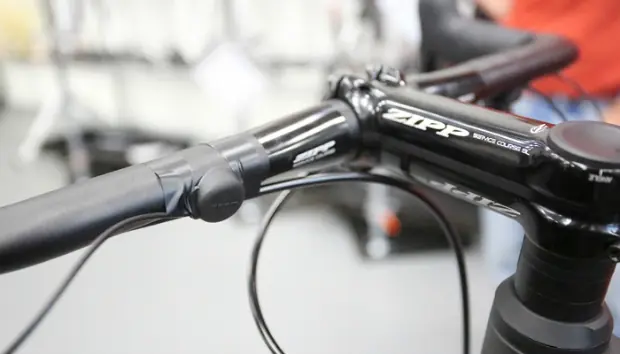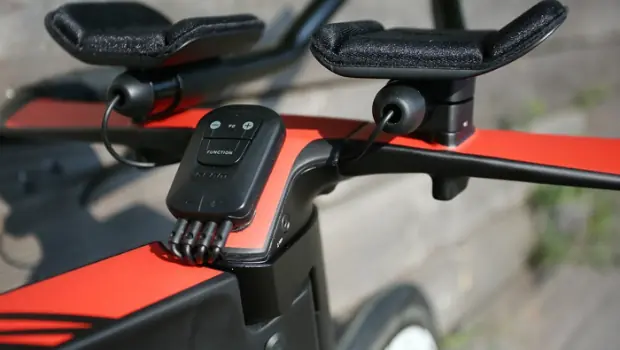
FRONT DERAILLEUR
It's remarkable to think that a tiny CR2032 battery and this wireless protocol has the capability of moving a motor strong enough to pull a chain from the small ring to the big, but it's to the task. All the SRAM basics--YAW arced cage throw, on a derailleur with a stiff steel outer and inner cage (titanium proved too flexy), and an aluminum tail. It will weigh 187 grams with the battery, and 163g grams without.
The batteries are fully waterproof, the contacts impervious to corrosion. They're interchangeable as well; in the unlikely event a rear derailleur battery goes dead, a user can quickly shift into a chosen front ring, then switch the live battery to the back to kick-start shifting in back again. In that event, it's a race-saver.
Battery wear indicators for the derailleurs road shifters and blip box? Simply shift the bike, and an indicator light will light up with every shift. Green means full to 15 hours of battery life left. A single red flash is a warning that the battery has between 15 and 5 hours of life left. Five rapid-succession flashes is your final warning; five to zero hours ride time left. Time to hit the pharmacy, or photo shop, or grocery store, wherever you get your CR2030 batteries.
To answer the 1X question: no, eTap will not be 1X compatible; it was designed for two chainrings, and the rear derailleur's 28-tooth capacity doesn't have long cage capabilities that 1X requires.
AIREA: SRAM's WIRELESS PROTOCOL
To start, going wireless is a big, big deal. Heretofore, electronic units require a battery to power the system, hidden (sometimes exposed) somewhere on the bike with a unit that adds weight and another component to maintain and care for. SRAM's Airea protocol instead powers each unit wirelessly through a standard CR2032 battery. Each component has a built-in accelerometer, so when the bike ceases to move for more than 30 seconds, it goes to sleep, saving battery life.
Getting a shifter to relay a message to a front and rear derailleur is a hell of a task. While initial thought led to Bluetooth or ANT+ as a potential wireless relay, SRAM realized those systems would not serve their needs, so engineers looked outside the obvious, and invented their own. They tore down cell phones, and looked at F1's paddle shifting as an inspiration. "We were already experts in mechanical assembly, so we decided to become experts in electronics," said Scott McLaughlin, Global Director of Drivetrain Production.
The protocol is called Airea. It's a 128-bit encrypted. It's impossible to hack, and tested against multiple units simultaneously in an effort to replicate an entire pro peloton field on eTap, shifting 28 shifters at the exact same time to run through 440 concurrent shifts, it was impossible to cross-match with another unit.
They then tested the system. Hard. First came internal lab testing at their centers in Schweinfurt, Chicago, Taiwan and San Luis Obispo, Calif.; wet, dry, salt corrosion, aggressive power washing (for 30 minutes straight), and thermal shock (simulating a day baking in a car under an Arizona summer sun at 145 degrees, then hitting it with cold water). And more; Nokia's tumble test. Dirt and dust ingress. Water ingress (submerging all parts in a tank at a meter for an hour). Vibration (simulation of 10 years of use akin to the test used in the auto industry on unsprung parts on a car like ABS braking. Chemical compatibility (WorldTour mechanics are known for their use of horrific diesel gas on bike parts). SRAM had a hiccup years back with their hydraulic debut when a cold-related issue caused a recall. SRAM doesn't want it to happen again.
Software updates? Well, it'd be a shame if it couldn't be done wirelessly, wouldn't it? SRAM provides a thumb drive that will serve to relay any updates to your eTap groupset. Further, SRAM worked extensively with Garmin on future communication capability between eTap and Garmin devices, advances that are still well into development, but not yet ready for prime time.

LESS IS MORE: SRAM'S BLIP BUTTONS
To compliment the road brake shifting experience, SRAM introduces Blip Buttons. The little round flat buttons that serve as integrated "satellite" shifters depress with a firm click, and can be placed anywhere on a road bike; on the top of road drops for shifting from the tops, or anywhere on the drops for sprint shifting. Just decide where you want it, put bar tape over it and voila; you have a custom shifter.
But for triathlon, the Blip Buttons serve a bigger role: bar end shifting. Now, there's no need for anything to plug into the bar end. Cut your bar to fit, install a set of Blip Buttons wherever you like and you're in business. And there's no need to remove your hands from the aerobars, ever; as with the road shifters, the Blips operate the same; right button goes down the cassette, outboard of the bike's midline; left button goes up, bringing the chain in and up the range. And of course, hitting both buttons simultaneously shifts the front chainring.
At the moment, just two sets of Blip Buttons can be mounted and installed into the Blip Box. So that means probably bar end and brake lever shifting only. Perhaps down the road we'll see a third port for a basebar shifter, but for now, it's servicing a triathlete's basic needs of bar end and brake lever shifting.
Weight on the Blip Buttons? This is a massive weight savings compared to any TT bar end shifter; anywhere from 6 to 9 grams. Customers will get sets Blip Buttons with 150mm cables (6g each), 230mm (7g(, 450mm (8g) and 650mm (9g), depending on placement, whether close to the stem or far out on long aerobar extensions.
With Blip Buttons comes the Blip Box. While only recently discovered on some WorldTour bikes (they were cleverly hidden on Frodeno's bikes within separate containment unit in the fluid reservoir), the Blip Box serves as the message board for the Blip Buttons, wirelessly sending the relay from the Blips to the derailleurs. The only connect is between the blips and the box; there's no other connect. The Blip Box is powered by a CR2032 battery, uses 128-bit encryption and.

Initially, the Blip Box was not to be run internal of a frame (the wireless signal strength takes a dive when encased in signal-blocking carbon fiber) but engineers learned that the blip cables running to the box serve as an antenna, so It can be hidden within the confines of a frame (perhaps a cowling like the Felt DA's frame-integrated fuel box just not too deep. Carfrae's Kona DA has that capability, but we saw one of her eTap-equipped bikes at the wind tunnel in Indianapolis, and it was set up externally on a custom between-aerobars bracket, leaving her frame's fuel box open for just that: fuel.
And the benefit of having the Blip Box located externally; it serves as a micro-adjust. In a race, if getting a wheel change, users can micro-adjust the unit on the fly in the middle of a race; no barrel adjusters to fuss with.
The Blip Box will feature a quarter-turn base, allowing it to be affixed to any Garmin-style bracket.
OTHER BLIP APPLICATIONS
Electronic has been a massive tech improvement for challenge and Paralympic athletes; with Blip Button technology, the tech goes even further; again placing a simple shift button anywhere that bests suits an athlete's ergonomic choice or limitations.
ON THE ROAD
The proof is in the pudding, and it's not a stretch to keep it cogent: this is in our two-day nickel tour the best electronic system on the market. We embarked on two three-hour rides, up steep pitches, down sketchy descents and out along lazy rolling hill and dale.
On the cobbles, not a hiccup. Nothing rattled loose, nothing missed a shift on a particularly rattling cobble descent that saw a bottle pop out of our cage.
More: 7 Equipment Choices That Guarantee A Faster Bike Split
As advertised, the intuitive nature of the system took all of two minutes to get familiar with... then it was mindless shifting. It's simply to consider where you want the rear derailleur to go, and to tap the shifter on that side of the direction. Equally, the front derailleur action was mindless.
I always consider two places to really test a group's shifting capability: at the bottom of a climb (where we dump into the small ring and swing across the cassette range) and at the crest of a rise (where we carry back into the big ring and sweep back up the cassette) It's the critical point where we can multi-task a system into a swift, smooth transition from descending to climbing, and climbing to descending.
That established, I loved the ability to change the front derailleur, then swing through the cassette range--while completely in the aerobars. This, my friends, is a triathlon first. Want to talk about keeping your aero position? SRAM RED eTap is the first group to truly give you that capability, with all action achieved from the aerobars. Conceivably, an athlete could complete the rolling Ironman Wisconsin course from T1 to T2 without leaving the aerobars other than to intake calories.
After our first ride, SRAM mechanics asked if there's anything we'd do differently. "Well, I'd move the blips on the top of the road drops from directly underneath to a bit forward on the bar," I said. The next morning, they simply unwrapped the bar tape, moved the buttons forward, then re-wrapped the tape. At our request, they also installed a set of clip-on aerobars, with Blip Buttons on the extensions as well.
The potentials for mount locations are endless for triathletes. While SRAM will likely provide a light double-stick tape to aid with affixment to the bar before placing bar tape over it, a bit of rubberized adhesive can cleanly lock a Blip into place, allowing for exposed install. And depending upon the stiffness of your bar tape (light cosmetic wrap versus thick cork, etc.) an exposed shifter as seen here on the Canyon SpeedMax AF, might be the way to go. For one, it's water-resistant, but secondly, the button recess is such that a bar-wrapped Blip Button requires a bit more of a "poke" into the button to actuate a shift. Setup food for thought.
Further, the elimination of plug-in bar end shifters leaves some riders absent something to grab, and creates some issues for UCI-regulated athletes. So today, Zipp announces the debut of the Vuka Alumina Evo alloy extensions, with a new upward kick and a bit of an ergonomic 20mm inward bent. SRAM and Zipp engineers said the new shape of the $55 extensions (which ship in September and will be seen on some of this season's show bikes) works well ergonomically with the utility of Blip Buttons for a low-strain grip.


